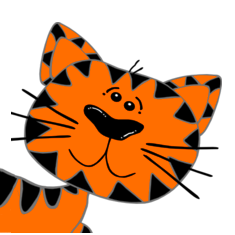A civet is not a cat??
-
 by
Boleyn
moderator
by
Boleyn
moderator
yshish comment left me quite confused. Why is a Civet not a cat? in German a Civet is a "Zibetkatze" in the family of the "Schleichkatze", the german word for viverrids. And "katze" means cat. The superfamily for Schleichkatze is Feloidae - catlike.
German wiki entry for civet So I asked yshish about their comment.yshish answered as follows: "I wasn't sure so I checked the taxonomy in both, English and Czech Wiki:
https://cs.wikipedia.org/wiki/Cibetkovití .In the Czech, the Viverridae family is directly under Carnivora.
The suborder Feliformia is missing in the Czech taxonomy since we don't use it.
Cats are Felidae family only, in my language. So this explains the confusion."So obviously we do have some kind of language problem.
May I suggest that if the scientists do not want us to classify civets and genets as small_cats then they might consider to add a class "viverrids" on the classifying site. Otherwise there will probably be lots of wrong classifications because I think there are quite many Germans or German speaking people on the platform.If this is not possible maybe they could at least add some clarifiying words to the field guide? Would be great!
Thanks!
Posted
-
 by
yshish
moderator
by
yshish
moderator
Thanks for your remark, @Boleyn !
As you said, Feliformia are 'Cat-like' animals, so Viverridae aren't Cats as it may seem from the classification.
The Field Guide shows (a day-light) image example of a Genet for the Other (non-primate) category. So please, use this category (instead of the Small cats one) for all Viverridae, like Genets and Cibets. But the words "Viverrid", "Genet" and "Civet" are unfortunately missing in the category description. I agree that it would be helpful to edit that and mention them there.
Hope it is clearer to all German volunteers now 😃
Thanks again, and sorry for the confusion.
Z.
Posted
-
 by
jwidness
moderator
by
jwidness
moderator
I'm guessing the reason "katze" is found in the word for civet in German is the same reason the word "maus" (mouse) is found in the word for bat (Fledermaus) -- not because it is a cat (clearly a bat isn't a mouse), but because it looks similar to one.
Still, more clarification is always better 😃Posted
-
 by
AnLand
moderator
by
AnLand
moderator
I did not have the problem, as somebody told me in the very beginning how to classify them correctly, but besides the misleading historical naming (that is normal in each language I guess as things are getting names often before scientific classification) Wikipedia is here a bit misleading for non-experts, I think. (But it is correct and as @yshish stated: cat-like is not cat.)
And by the way: German wikipedia also states that female chimps going into menopause with 40 years. 😉
Posted
-
 by
yshish
moderator
by
yshish
moderator
Well, I have no idea what percentage of volunteers have never visited the Talk but keep coming back to classify. Some of them may also consider Viverrids as Small cats since they're not named in the Field Guide. If it was possible to edit the text, I think it could help, especially when a lot of German users are supposed to contribute.
Posted
-
 by
Mercury82
by
Mercury82
I'm Austrian, so also German speaking, and I knew that viverrids are not cats, even if the wording would suggest it. I think the field guide is clear enough at this point.
Posted
-
 by
yshish
moderator
by
yshish
moderator
Good to hear! Thanks
Posted
-
 by
Boleyn
moderator
by
Boleyn
moderator
Thanks guys, I'm sure this clarification will help not only me!
Of course Wiki is only as good as it's editors, I know that very well. However it wasn't obviously clear to me that catlike animals do not belong into the cats category.
Since genets (and civets) are night active animals the idea never crossed my mind that the pic of a genet in the field guide actually IS a genet. I would have expected a night pic I think. Additionally I was also misled by a tour guide we had in Botswana. One evening we have seen the eyes of a serval, a civet and a genet at night by scanning the aera with torches. The guide then told us: "today you have seen 5 different cats: lion, leopard, serval, civet, genet". Viverrids? Never heard this expression before ... 😃
Posted
-
 by
Boleyn
moderator
by
Boleyn
moderator
I just found this video of a genet in the Dailyzoo collection. ACP000g128
To me it looks as if it's marking the log with its flank glands rather than scratching itself.
Do we have some viverrid experts here who could verify? Thanks a lot!This behaviour once more is very catlike and I think it's not astonishing that in some cultures the viverrids are called "Schleichkatzen" (katzen for cats).

Posted
-
 by
ksigler
moderator
in response to Boleyn's comment.
by
ksigler
moderator
in response to Boleyn's comment.
@Boleyn - I was curious about this behavior, as well. I located this book, Comparative Ethology of the
Large-spotted Genet (Genetta tigrind) and Some Related Viverrids, that describes similar behaviors in both genets and civets.Excerpt from pages 21-22:
Though genets occasionally lie down and rub and roll with
sinuous movements of the spine similar to a dog,
the behavior is performed most frequently if the
animal's fur is saturated with water. In addition, a
wet animal often propels its body forward with the
hindlegs while sliding the side of the head, neck,
and shoulder on the substrate.And pages 24-26 describe neck sliding:
Diicker's (1971) male and female Nandinia
would slide the chin, neck, and sides of the
head, as well as the breast for up to 15 minutes on
a board that had been used for cutting liver. This
behavior was also elicited by solutions of heliotrope
(Baldriantinktur) and cologne.It goes on to describe other behaviors for scent-marking, grooming, and social interaction. I didn't read the entire document, so you may want to read it yourself for further insights. Based on the above excerpts, I would guess it's related to having wet fur or an interest in transferring some scent from the log onto itself. If you find something else out, though, please share it. 😃
Posted
-
 by
Boleyn
moderator
in response to ksigler's comment.
by
Boleyn
moderator
in response to ksigler's comment.
Thank you so much for taking your time to look into this @ksigler and for the link!
That's very interesting. I think it's the log where we have been seeing chimps and monkeys sitting and resting. Probaly also other animals. So maybe this genet tries to get some of the perfumes of those species into it's fur. Or have you been seeing somebody hacking liver on that log? 😄 😄
In any case - it's just a very nice and cute video. Thanks again!
Posted
-
 by
ksigler
moderator
in response to Boleyn's comment.
by
ksigler
moderator
in response to Boleyn's comment.
lol Hacking liver on the log... hey, it's possible. 😃 You're welcome for the link. It's a fascinating read.
Posted